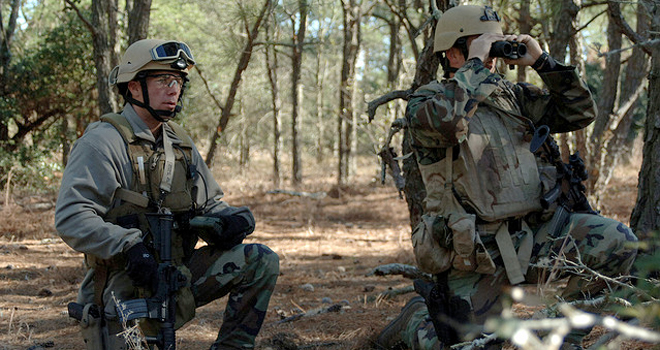The U.S. Navy’s bomb squads have a weight problem. To keep their field gear powered up, the typical explosive ordnance disposal unit has to haul fifty pounds of specialized chargers and related devices around, creating an unwieldy and potentially dangerous drag on the operation.
Now help is coming from an unexpected source: the sun.
The Navy’s Explosive Ordnance Disposal Training and Evaluation Unit 2 in Virginia has been testing five prototype lightweight field power kits that include solar cells as a key component. The kits replace fifty pounds of equipment with a compact system that weighs only about nine pounds.
The heart of the kit is a one-pound device called a Soldier Power Manager. The Power Manager functions like a smart micro-mini-grid. In contrast to a portable generator that runs only on diesel fuel, the Power Manager can receive energy from various sources including solar panels and fuel cells. It recharges other devices by cable attachments, eliminating the need for individual battery chargers.
The “smart” part of the Power Manager is its advanced graphics system, which enables users to track power consumption and power availability in real time – a crucial capability during sensitive operations.
The other eight pounds of the kit include photovoltaic cells that roll up like a blanket and a set of common rechargeable batteries.
The kits were developed by the Office of Naval Research’s TechSolutions program, which focuses on responding to requests for help with technology-related problems that bedevil Navy and Marines personnel in the field.
Though the concept is basically the same as an old fashioned employee suggestion box, a single request can have a profound effect on operations. In one recent example, TechSolutions has been testing high efficiency LED bunk lights in response to a sailor’s complaint about noisy, outdated fluorescent fixtures. Aside from improving readiness and health the new lighting system has already yielded significant savings in energy, maintenance, storage and disposal logistics, and it may soon go fleetwide.
TechSolutions has a goal of delivering results within 12 months or less, so the new solar power kits could be adopted across the board sooner rather than later.
If the idea of solar-powered bomb squads sounds a bit far-fetched, you’ve got some catching up to do. Solar power is becoming standard issue at U.S. military bases, the latest example being a solar project the size of Manhattan under way at Fort Irwin.
Solar energy is also being introduced to forward operating bases in Afghanistan, including stationary installations as well as portable solar-enabled, backpack style power kits similar in concept to those undergoing testing by Evaluation Unit 2.
Programs like TechSolutions are going to become increasingly important given the military’s growing reliance on electronic gear and its need for new forms of energy management – but that is also a cause for future concern. In a speech to Mississippi state legislators last spring Secretary of the Navy Ray Mabus noted that the drive to reduce funding for public education is undercutting the military’s need for tech savvy recruits who possess the intellectual sophistication to manage both their equipment and their mission.









